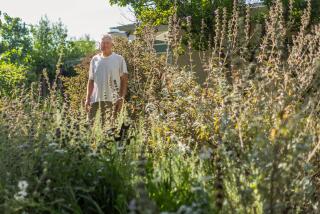Iced Plants : Freeze Took Heavy Toll on Yards and Some Nurseries, but Experts Say Don’t Prune until Spring
- Share via
The anxious phone calls are coming in steadily to nurseries throughout the San Fernando, Santa Clarita and Antelope valleys: My lantana is shriveled. What do I do with my brown and sickly bougainvillea? Should I clip my ficus tree?
From the ground cover in residential yards to trees raised by wholesalers to the tropical vines in the Cal State Northridge botanical gardens, last month’s freeze was devastating for already drought-weary local flora.
Although agriculture experts estimate that the freezing that began Dec. 21 caused $12 million in damage to Los Angeles County landscaping and agriculture, their advice to worried homeowners, in sum, is to do nothing until spring.
Until then, most plants will not be looking their best.
“I see the damage everywhere, especially in our own botanical garden,” said William Emboden, who teaches botany at Cal State Northridge. “It doesn’t look like a botanical garden any longer. It looks like a war zone.”
Jo Kitz, president of the California Native Plant Society, said the freeze wiped out the jade plant in the yard of her Woodland Hills residence. Her next-door neighbor has a garden full of brown, dying geraniums.
“Every other call we’re getting is about frost-damaged plants,” said John Mahler of Greenthumb International in Newhall. “People lost plants that they’ve had in their yards for years.”
The extent of the damage will not be certain until late spring because of the ability of many plants to rebound even when they appear dead.
Boething Treeland Farms in Woodland Hills, which suffered damage to its Ventura and San Joaquin valley growing areas, is warning its customers in a newsletter not to overreact to the plant damage. Pruning plants now could be disastrous if another cold wave hits before spring, said Haydi Danielson, director of operations.
Parks officials in Los Angeles, Burbank and Agoura Hills say they are adopting the same wait-and-see attitude.
“When the leaves are all drooping and yellow, people have a tendency to want to clip them off,” said Jack Wick, a spokesman for the Sacramento-based California Assn. of Nurserymen. “Do not do it.”
Pruning the plant now will allow vulnerable new sprouts to grow, said Wick, who lost a 35-year-old Robertson orange tree in the yard of his Sacramento Valley residence.
Industry experts disagree on whether the freeze--the worst since 1937--would result in a boom at retail nurseries in the spring or whether the drought and faltering economy would keep potential purchasers home.
“Some people will say, ‘Ohhhh. Should I keep plants in my yard if I can’t water them?’ ” said Don Zimmerman, operations manager at Armstrong Garden Center, which has 21 locations throughout Southern California. He called such fears unmerited.
“It all depends on the economy,” said Bob Donley, deputy director in the county agriculture commissioner’s office. “If people don’t have a lot of money to spend, they’ll spend it on things besides plants.”
Donley said he will probably wait a year or two to replace the three young ficus plants he lost in his back yard.
Wholesalers say shortages of some plants could develop. Damaged camellias and azaleas, for example, both popular Valentine’s Day gifts, might bloom later than expected and create a shortage on the year’s busiest selling day.
Between fielding phone calls from concerned plant lovers, the nursery operators are assessing their own losses, which range from minor to staggering. The chill caused an estimated $12 million in damage to the county’s $182-million agriculture industry, Donley said.
While citrus growers were hardest hit elsewhere in the state, $10 million of Los Angeles’ losses were in flowers and ornamental plants and shrubs. The rest of the damage was to avocado growers in the Malibu area, a strawberry farm in the east San Gabriel Valley and a tomato grower in Palmdale.
“There has been a tremendous amount of horticultural damage both in residential yards and in nurseries,” said Stuart Sperber, president of Valley Crest Tree Co. in Sylmar, where heavy losses to its stock of ficus, bougainvillea and hibiscus were uninsured.
Sperber, who has been in business for more than 41 years, rushed to the aid of his plants with agricultural heaters when the cold wave hit in late December, but the temperatures dropped so low that the heaters were ineffective.
“We’re just going to swallow hard, dump the plant material and start all over again,” he said.
PROTECTING PLANTS IN A FREEZE
* Move potted plants indoors or out of the wind.
* Cover the bark of trees with burlap or other cloth for insulation.
* Make sure plants are watered well when the freeze hits.
* Cover sensitive ground cover and other plants loosely with plastic.
* Spray the leaves of plants with water if temperatures are to dip below freezing.
Source: Los Angeles Cooperative Extension






